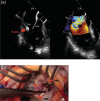Percutaneous edge-to-edge repair of severe mitral regurgitation using the MitraClip XTR versus NTR system
- PMID: 33760247
- PMCID: PMC8119798
- DOI: 10.1002/clc.23599
Percutaneous edge-to-edge repair of severe mitral regurgitation using the MitraClip XTR versus NTR system
Abstract
Background: Transcatheter mitral valve repair (TMVR) has shown to improve symptoms and functional capacity in patients with severe mitral valve regurgitation (MR). Novel device developments provide the technology to treat patients with complex anatomies and large coaptation gaps. Nevertheless, the question of superiority of one device remains unanswered. We aimed to compare the MitraClip XTR and MitraClip NTR system in a real world setting.
Hypothesis: TMVR with the MitraClip XTR system is equally effective, but associated with a higher risk of leaflet injury.
Methods: We retrospectively analyzed peri-procedural and mid-term clinical and echocardiographic outcomes of 113 patients treated for severe MR between March 2018 and August 2019 at the University Hospital of Munich.
Results: Postprocedural MR reduction to ≤2+ was comparable in both groups (XTR: 96.1% vs. NTR: 97.6%, p = .38). There was a significant difference in a composite safety endpoint of periprocedural Major adverse cardiac and cerebrovascular events (MACCE) including leaflet injury between groups (XTR 14.6% vs. NTR 1.7%, 95% CI [2.7, 24.6], p = .012). After a median follow-up of 8.5 (4.4, 14.0) months, durable reduction of MR was confirmed (XTR: in 91.9% vs. NTR: 96.8%, p = .31) and clinical and symptomatic improvement was comparable in both groups accordingly.
Conclusion: While efficacy was comparable in both treatment groups, patients treated with the MitraClip XTR systems showed more events of acute leaflet tear and single leaflet device attachment (SLDA). A detailed echocardiographic assessment should be done to identify risk candidates for acute leaflet injury.
Keywords: leaflet injury; mitral valve regurgitation; single leaflet device attachment; transcatheter mitral valve repair.
© 2021 The Authors. Clinical Cardiology published by Wiley Periodicals LLC.
Conflict of interest statement
Daniel Braun, Mathias Orban and Michael Nabauer received speaker honoraria from the Abbott Vascular. Joerg Hausleiter received speaker honoraria from and serves as consultant for Abbott Vascular and Edwards Lifesciences.
Figures



Similar articles
-
Transcatheter edge-to-edge repair for secondary mitral regurgitation with third-generation devices in heart failure patients - results from the Global EXPAND Post-Market study.Eur J Heart Fail. 2023 Mar;25(3):411-421. doi: 10.1002/ejhf.2770. Epub 2023 Jan 16. Eur J Heart Fail. 2023. PMID: 36597850
-
Comparison of transcatheter tricuspid valve repair using the MitraClip NTR and XTR systems.Int J Cardiol. 2021 Mar 15;327:156-162. doi: 10.1016/j.ijcard.2020.11.073. Epub 2020 Dec 7. Int J Cardiol. 2021. PMID: 33301831
-
Transcatheter mitral valve repair with MitraClip: comparison of NT, NTr, and XTr Devices.J Invasive Cardiol. 2024 Aug;36(8). doi: 10.25270/jic/24.00020. J Invasive Cardiol. 2024. PMID: 38598251
-
Recent advances in patient selection and devices for transcatheter edge-to-edge mitral valve repair in heart failure.Expert Rev Med Devices. 2020 Feb;17(2):93-102. doi: 10.1080/17434440.2020.1714433. Epub 2020 Jan 21. Expert Rev Med Devices. 2020. PMID: 31923376 Review.
-
Clinical outcomes of percutaneous mitral valve repair with MitraClip for the management of functional mitral regurgitation.Catheter Cardiovasc Interv. 2019 Nov 15;94(6):820-826. doi: 10.1002/ccd.28203. Epub 2019 Apr 1. Catheter Cardiovasc Interv. 2019. PMID: 30938045 Review.
Cited by
-
Thirty-day and one-year outcomes following transcatheter mitral valve edge-to-edge repair versus transapical mitral valve replacement in patients with left ventricular dysfunction.AsiaIntervention. 2023 Mar 15;9(1):78-86. doi: 10.4244/AIJ-D-22-00049. eCollection 2023 Mar. AsiaIntervention. 2023. PMID: 36936096 Free PMC article.
-
Early Outcomes of Two Large Mitral Valve Transcatheter Edge-to-Edge Repair Devices-A Propensity Score Matched Multicenter Comparison.J Clin Med. 2024 Jul 17;13(14):4187. doi: 10.3390/jcm13144187. J Clin Med. 2024. PMID: 39064227 Free PMC article.
-
One-Year Outcomes According to Mitral Regurgitation Etiology Following Transcatheter Edge-to-Edge Repair With the PASCAL System: Results From a Multicenter Registry.J Am Heart Assoc. 2023 Dec 19;12(24):e031881. doi: 10.1161/JAHA.123.031881. Epub 2023 Dec 12. J Am Heart Assoc. 2023. PMID: 38084735 Free PMC article.
-
Standardised definitions of transcatheter edge-to-edge repair leaflet adverse events: identifying complications or complicating identification?EuroIntervention. 2021 Dec 3;17(11):e872-e874. doi: 10.4244/EIJV17I11A147. EuroIntervention. 2021. PMID: 34870599 Free PMC article. No abstract available.
-
A Simulation Study of the Effects of Number and Location of MitraClips on Mitral Regurgitation.JACC Adv. 2022 Mar 21;1(1):100015. doi: 10.1016/j.jacadv.2022.100015. eCollection 2022 Mar. JACC Adv. 2022. PMID: 38939090 Free PMC article.
References
-
- Watkins DA, Johnson CO, Colquhoun SM, et al. Global, regional, and national burden of rheumatic heart disease, 1990‐2015. N Engl J Med. 2017;377(8):713‐722. - PubMed
-
- Benjamin EJVS, Callaway CW, Callaway CW, et al. Heart disease and stroke statistics ‐ 2018 update: a report from the American Heart Association. Circulation. 2018;137(12):e67‐e492. - PubMed
-
- Obadia JF, Messika‐Zeitoun D, Leurent G, et al. Percutaneous repair or medical treatment for secondary mitral regurgitation. N Engl J Med. 2018;379(24):2297‐2306. - PubMed
-
- Del Forno B, De Bonis M, Agricola E, et al. Mitral valve regurgitation: a disease with a wide spectrum of therapeutic options. Nat Rev Cardiol. 2020;17(12):807‐827. - PubMed
-
- Vahanian A, Alfieri O, Andreotti F, et al. Guidelines on the management of valvular heart disease (version 2012). Eur Heart J. 2012;33(19):2451‐2496. - PubMed
MeSH terms
LinkOut - more resources
Full Text Sources
Other Literature Sources

